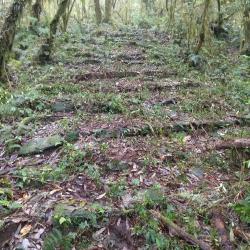The Zhongzhiguan Police Post is located in the Taoyuan District of Kaohsiung City. It is an extremely important stop on the Guanshan Historic Trail because it overlooks Yusuishe from there, and monitors the then Bunun chief, Lahu·Ali, who lived opposite Zhongzhiguan, on the upper reaches of the Lunong River. Lahu·Ali, who has fought continuously against the Japanese for 20 years, once visited the Zhongzhiguan Police Post twice and came to a peaceful settlement there. In fact, the Zhongzhiguan Police Post had a huge establishment, and the police department with the highest rank was stationed here for a long time.
Today, the historic trail section between Tianchi and Zhongzhiguan is made into hiking trails by the Yushan National Park. There are also tourist rest stops and information boards at the ruins of the Zhongzhiguan Police Post.
